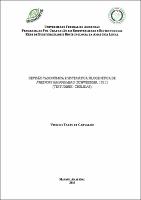| ???jsp.display-item.social.title??? |


|
Please use this identifier to cite or link to this item:
https://tede.ufam.edu.br/handle/tede/6112| ???metadata.dc.type???: | Tese |
| Title: | Revisão taxonômica e sistemática filogenética de Phrynops geoffroanus (Schweigger, 1812) (Testudines: chelidae) |
| ???metadata.dc.creator???: | Carvalho, Vinícius Tadeu de  |
| ???metadata.dc.contributor.advisor1???: | Farias, Izeni Pires |
| First advisor-co: | Vogt, Richard Carl |
| ???metadata.dc.contributor.referee1???: | Andrade, Paulo Cesar Machado |
| ???metadata.dc.contributor.referee2???: | Rezende, Cleiton Fantin |
| ???metadata.dc.contributor.referee3???: | Souza, Antonio Queiroz Lima de |
| ???metadata.dc.contributor.referee4???: | Maia, Jair Max Furtunato |
| ???metadata.dc.description.resumo???: | Os cágados são quelônios de água doce pertencentes a subordem Pleurodira, estão incluídos na família Chelidae que atualmente está representada por 56 espécies. O gênero Phrynops endêmico da América do Sul possui quatro espécies nominais: Phrynops geoffroanus, P. hilarii, P. tuberosus e P. williamsi, a primeira espécie apresenta a maior distribuição geográfica entre todos os representantes da família Chelidae. Distribuindo-se desde o sul da Venezuela ao norte da Argentina. Considerando sua ampla distribuição geográfica diversos autores tem indicado a possível existência de um complexo de espécies que será fracionado em entidades distintas. A única reavaliação do gênero Phrynops ocorreu no início dos anos 2000. Entre os anos de 2010 e 2015 foi coletado 223 espécimes provenientes de todas as regiões do Brasil, norte, nordeste, centro-oeste, sudeste e sul abrangendo grande parte de sua distribuição geográfica atualmente conhecida. As coletas foram realizadas utilizando diversos métodos de coleta como armadilhas do tipo covo “hoop traps”, malhadeiras “trammel nets”, anzóis (esperas) e malhadeiras. Dados morfométricos e moleculares (genes mitocondriais, nucleares – dados genômicos) tem sido ferramentas importantes para auxiliar na delimitação de linhagens evolutivas distintas e os seus respectivos limites de distribuição geográfica. Utilizando sequenciamento do mtDNA dos genes 16S, Citocromo b e Citocromo oxidase I com o intuito de estudar e revelar os padrões de diversidade genética de P. geoffroanus para testar a existência de diversidade críptica. Através de análises genética utilizando dados concatenados dos genes mitocondriais foi possível observar a distinção de cinco linhagens. Dados morfológicos também auxiliaram na distinção de agrupamentos formados pelas formas morfométricas dos espécimes estudados. Sugerimos a existência de diversidade críptica em P. geoffroanus que possivelmente venha ser fracionado em outras entidades taxonômicas. |
| Abstract: | Turtles are freshwater turtles belonging to the Pleurodira suborder, are included in the family Chelidae that at present is represented by 56 species. The genus Phrynops endemic to South America has four nominal species: Phrynops geoffroanus, P. hilarii, P. tuberosus and P. williamsi, the first species has the largest geographical distribution among all representatives of the family Chelidae. It is distributed from the south of Venezuela to the north of Argentina. Considering its wide geographical distribution, several authors have indicated the possible existence of a complex of species that will be divided into distinct entities. The only reappraisal of the genus Phrynops occurred in the early 2000s. Between 2010 and 2015, 223 specimens from all regions of Brazil, north, north-east, central-west, southeast and south were collected covering much of their geographic distribution currently known. The samples were collected using a variety of collecting methods such as "hoop traps" traps, trammel nets, hooks, and sanders. Morphometric and molecular data (mitochondrial genes, nuclear - genomic data) have been important tools to help delineate distinct evolutionary lineages and their respective geographical distribution boundaries. Using mtDNA sequencing of the 16S, Cytochrome b and Cytochrome oxidase I genes with the aim of studying and revealing the genetic diversity patterns of P. geoffroanus to test the existence of cryptic diversity. Through genetic analysis using concatenated data of the mitochondrial genes it was possible to observe the distinction of four lineages. Morphological data also helped to distinguish clusters formed by the morphometric forms of the specimens studied. We suggest the existence of cryptic diversity in P. geoffroanus that may possibly be fractionated in other taxonomic entities. |
| Keywords: | Quelônios - Linhagens evolutivas Quelônios - Diversidade genética Quelônios |
| ???metadata.dc.subject.cnpq???: | CIÊNCIAS BIOLÓGICAS |
| Language: | por |
| ???metadata.dc.publisher.country???: | Brasil |
| ???metadata.dc.description.embargo???: | Período de Embargo: 11/06/2017 - 28/02/2021 |
| Publisher: | Universidade Federal do Amazonas |
| ???metadata.dc.publisher.initials???: | UFAM |
| ???metadata.dc.publisher.department???: | Instituto de Ciências Biológicas |
| ???metadata.dc.publisher.program???: | Programa de Pós-graduação em Biodiversidade e Biotecnologia da Amazônia Legal - BIONORTE |
| Citation: | CARVALHO, Vinícius Tadeu de. Revisão taxonômica e sistemática filogenética de Phrynops geoffroanus (Schweigger, 1812) (Testudines: chelidae). 2016. 124 f. Tese (Doutorado em Biodiversidade e Biotecnologia da Amazônia Legal) - Universidade Federal do Amazonas, Manaus, 2016. |
| ???metadata.dc.rights???: | Acesso Aberto |
| ???metadata.dc.rights.uri???: | http://creativecommons.org/licenses/by-nc-nd/4.0/ |
| URI: | http://tede.ufam.edu.br/handle/tede/6112 |
| Issue Date: | 7-Dec-2016 |
| Appears in Collections: | Doutorado BIONORTE |
Files in This Item:
| File | Description | Size | Format | |
|---|---|---|---|---|
| Tese_ViniciusCarvalho_PPGBIOTEC.pdf | 147.43 MB | Adobe PDF |  Download/Open Preview |
This item is licensed under a Creative Commons License





